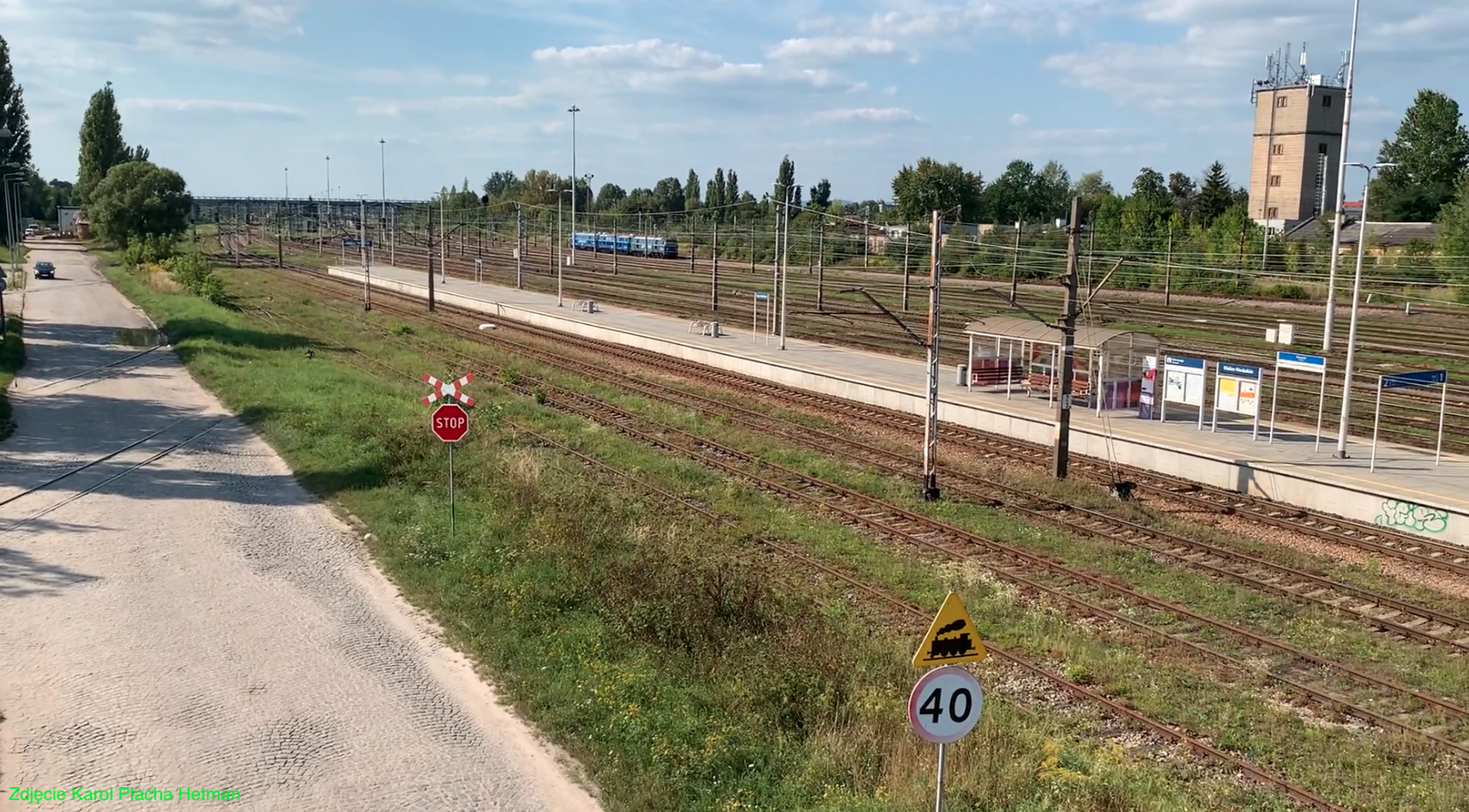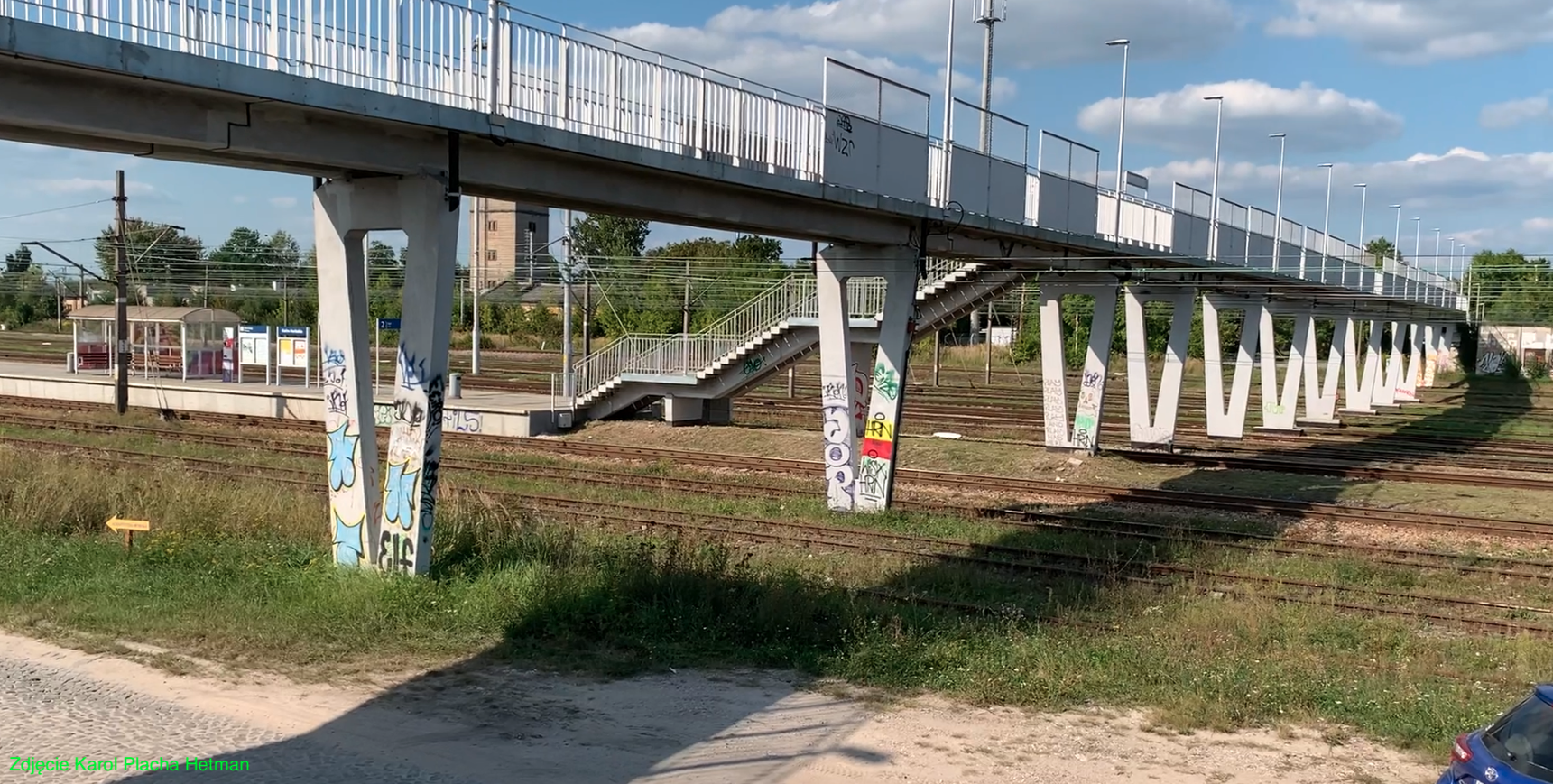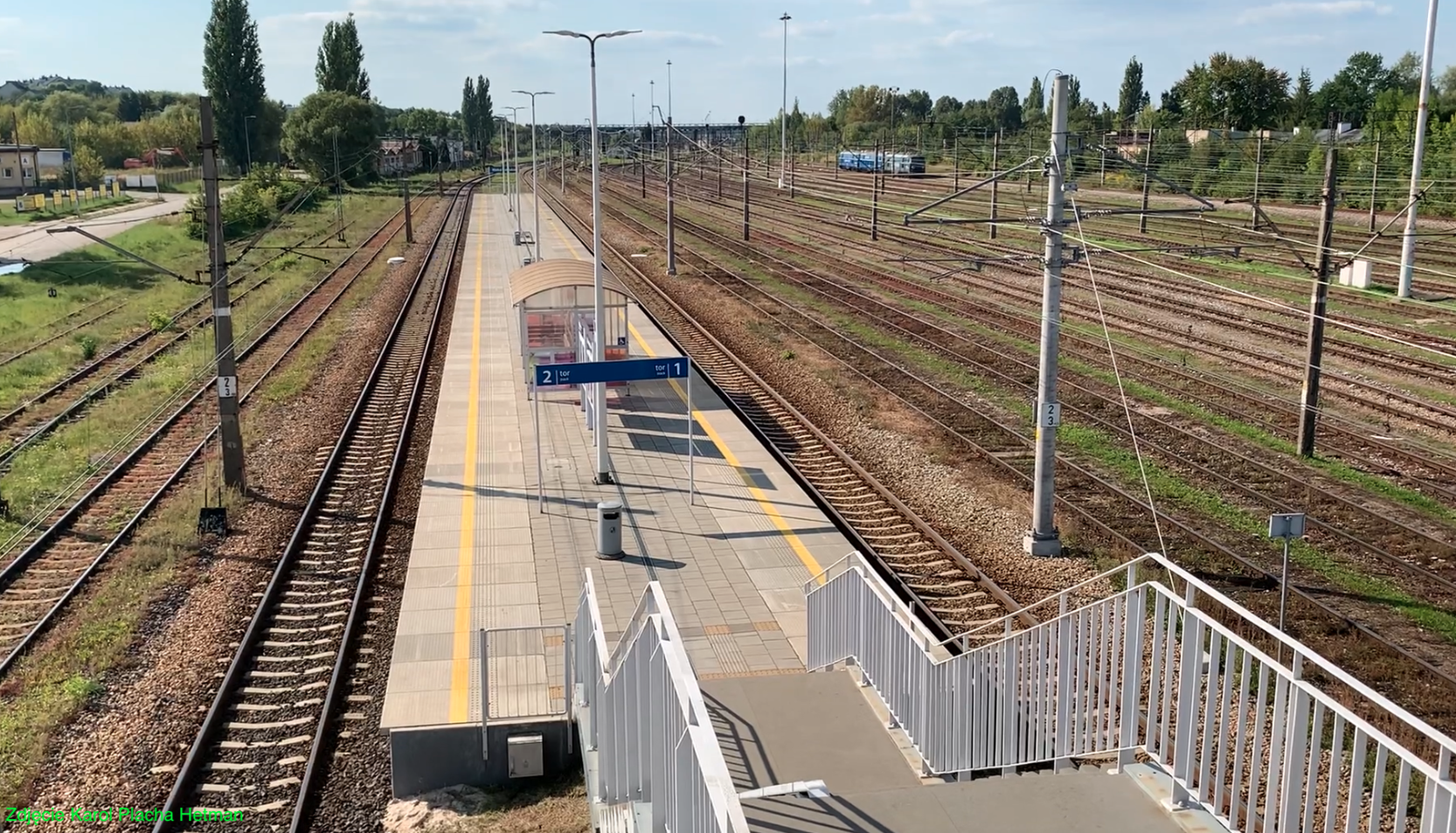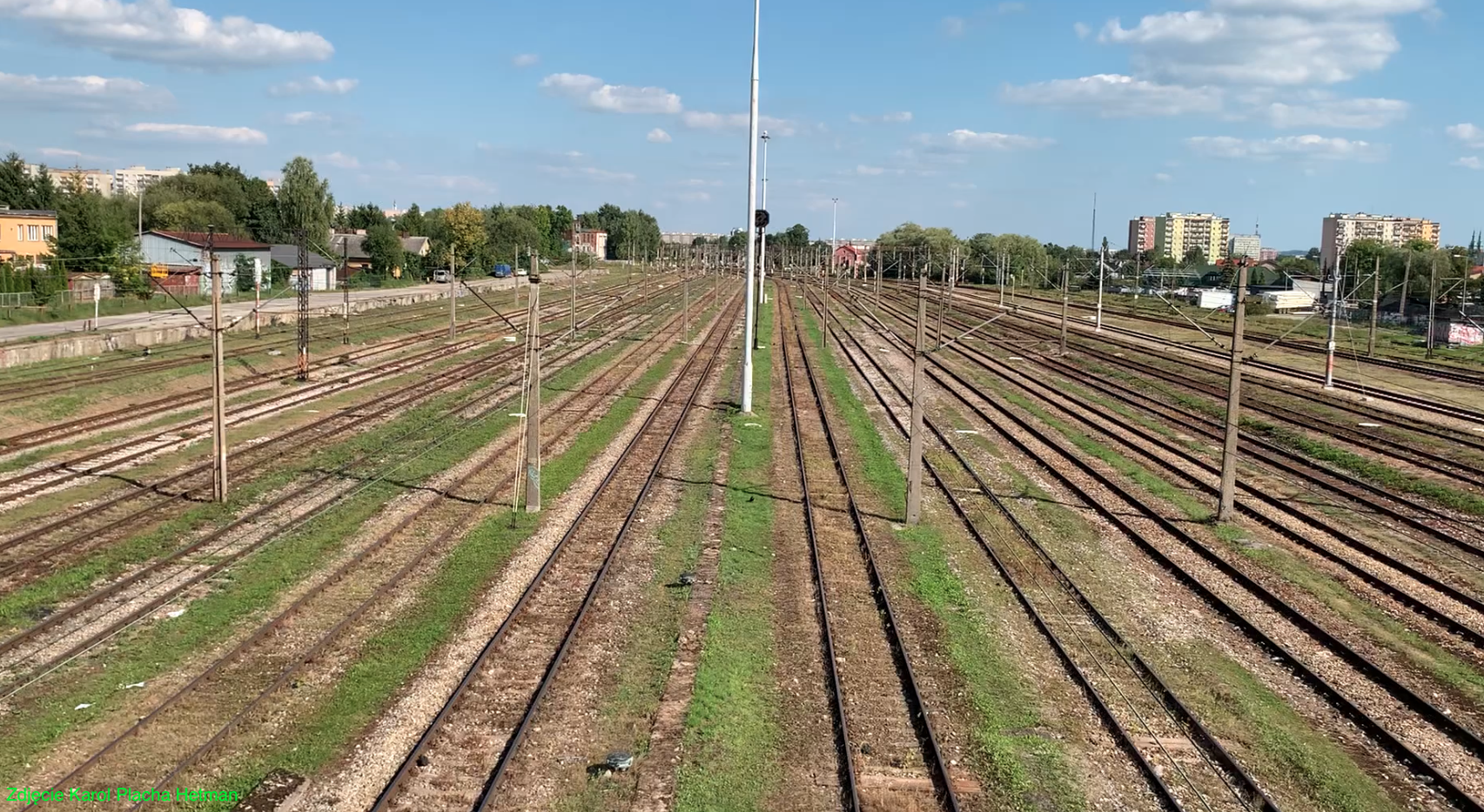Kielce 2023-09-22
Kielce Herbskie railway station.
Geographic coordinates: 50.886 N 20.603 E. Elevation 274 m. Station address: ul. Oskar Kolberga, 25-620 Kielce.
Kielce Herbskie is a large marshalling yard, but it also serves as a passenger station. In its area there is the Kielce Herbskie passenger stop in the eastern part and the Kielce Slichowice passenger stop in the western part. The station is located in the Świętokrzyskie Voivodeship, in the city of Kielce in the western part of the city. The station is a junction; Railway line No. 61 Kielce Główny - Fosowskie and railway line, slip road No. 567 Piaski near Kielce - Kielce Herbskie.




Railway line No. 61 Kielce Główny – Fosowskie.
Line No. 61 is a line running from the east and runs through the voivodeships; Świętokrzyskie, Silesian and Opole provinces. The line is 177,300 km long. The line is standard gauge, double-track, electrified, with a maximum speed of up to 120 km/h. The line was established as the Herbsko-Kielecka Railway.
The Herbsko-Kielecka Railway connected the Kingdom of Poland (Moscow Partition) with the Prussians (Prussian Partition) at the end of the 19th century. The line connected the towns; Kielce - Włoszczowa - Koniecpol - Częstochowa - Herby - Lubliniec. The line was not created as one project, but is a combination of several tasks. It was a time when the Muscovites were interested in economic cooperation with the Germans. The creation of the line was also pressured by the Germanic shareholders of the Warsaw-Vienna Railway, who also owned large shares in the Prussian railways. In 1867, they submitted an application to the Moscow tsarist administration to build the Częstochowa - Herby route. The application was rejected. But the manufacturers did not stop.
There were various concepts for routing the trail. The variant to Lubliniec and then Opole - Wrocław did not require large earthworks or engineering works. Another application for the construction of the Częstochowa - Herby line was submitted by the owners of the Warsaw-Vienna Railway. But the license was not granted. On December 1, 1891, the Prussians built the Lubliniec - Herby Pruskie section. On October 10, 1894, the Lubliniec - Fosowskie section was opened. The manager of the line on the Germanic side was the Prussian State Railways. In 1903, the Herby Ruskie - Częstochowa Stradom section was built, but only as a narrow-gauge railway line. It was a Moscow investment. In 1905, the Prussians connected Herby Pruskie and Herby Ruskie as a standard gauge line. In 1911, the Muscovites allowed the opening of the broad-gauge section Częstochowa Stradom - Kielce. The Częstochowa - Herby section was also converted to broad gauge. The Kielce - Częstochowa section, before implementation, had various versions of the route. Different priorities of Polish and Moscow manufacturers clashed here.
On February 26, 1911, passenger and freight train traffic was launched on the Kielce - Lubliniec section, with a change from wide-gauge wagons to standard-gauge wagons. In Lubliniec it was possible to change trains to Opole and Wrocław. Lubliniec is located 152 km from Kielce. When the Great World War broke out, Prussian troops, moving east, converted the wide track into standard gauge, European gauge of 1,435 mm.
On November 27, 1965, the Częstochowa Stradom - Liswarta section was electrified. On April 29, 1967, the Kielce - Kielce Herbskie section was electrified. On January 26, 1973, the sections of Liswarta - Lubliniec were electrified and on December 29, 1973, Koniecpol - Częstochowa Stradom. On December 4, 1974, the Kielce Herbskie - Koniecpol section was electrified. On December 18, 1976, the traction network on the Lubliniec - Fosowskie section was put into operation.
Renovations on the trail were carried out in the 1970s. However, these were renovations on short sections. Wooden sleepers were often replaced with reinforced concrete ones. The rails were replaced, but the contact rails were left. During electrification, shape signals were replaced with light semaphores.
In August 2012, the first tender for the renovation of line No. 61, covering the Koniecpol - Turów section (74.887 - 99.679 km), was concluded. Tenders for further renovations of sections were concluded in January 2013. The agreements were signed in mid-April 2013. The scope of work included not only the renovation of tracks and turnouts, but also the replacement of the traction network, renovation of platforms, railway and road crossings, bridges, viaducts and culverts. The scope was defined by PLK (Polskie Linie Kolejowe). The entire renovation of the Częstochowa - Fosowskie section cost PLN 325 million. The renovation was expected to be completed in November 2014. The deadline was met and from the beginning of December 2014, long-distance trains returned to the route without restrictions.
Currently (2023), the entire line is double-tracked and electrified. In 2014, as a result of modernization, the speed of trains increased to a maximum of 120 km/h.
Railway line No. 567 Piaski near Kielce - Kielce Herbskie.
Railway line No. 567 is actually a link between the Piaski station near Kielce and the Kielce Herbskie railway station. The line is single-track, electrified and has a length of 1,779 km. The line is electrified with a current of 3 kV DC. The maximum speed is 40 km/h. The switchboard was launched on February 26, 1911, and on December 4, 1974, electrification was completed.
Kielce Herbskie railway station.
The station is located on railway line No. 61, at 3,743 km.
Currently (2023), the Kielce Herbskie station has one island, two-edge platform, which was last renovated in 2019. There is no station building at the station. There is a bus stop shelter on the platform for travelers. In 2017, the station served up to 50 travelers per day. Passenger trains are operated by the PolRegio carrier. From the Kielce Herbskie station you can get to: Kielce (city center), Włoszczowa Północ, Częstochowa, Skarżyska Kamienna. During the day (September 2023), 27 trains stop at the station. Trains are accessible to passengers with bicycles. Currently, there are no trains adapted to the needs of wheelchair users.
The Kielce Herbskie station includes the Kielce Ślichowice passenger stop, which is located west of the Kielce Herbskie passenger stop. The Kielce Ślichowice stop has two single-edge platforms, 200 m long. Access to the platforms is at track level.
Generally, passenger traffic is carried on the tracks from the south. The northern side is occupied by the tracks of the freight station. Passenger traffic of Kielce residents is carried through two footbridges over the tracks. One footbridge is at the Kielce Herbskie passenger stop and connects Oskara Kolberga Street with Towarowa Street. The second footbridge is in the central part of the station and connects the Ślechowice wasteland at Jerzy Bogumiła Pascha Street (southern side) with Długa Street (northern side). Additionally, it is a technical viaduct with pipelines over the tracks.
After World War II, a water tower was built in the area of the station, which was operated until 1990. The water tower at the base is square and made of reinforced concrete. Currently, it serves as a position for mobile phone antennas. Near the locomotive shed there was a canal for cleaning locomotive boilers. There was also a railway scale and a gauge.
Locomotive shed - The fan shed was built in 1946. The locomotive depot had 22 stations. Access to the locomotive depot was from the eastern and western sides. In 2009, the locomotive depot was abandoned by PKP PLK. In 2017, as a result of its poor technical condition, the construction supervision issued a decision to demolish the facility (Provincial Construction Supervision Inspector in Kielce). The facility was demolished in 2018-2019. The remaining locomotive turntable. In 2018, the track leading to the locomotive depot was demolished.
There is a marshalling hill at the station, which is equipped with; track brakes, radar system, track and turnout vacancy control systems, free track length measurement systems. There are also traffic lights for the marshalling hill. The station is divided into two freight stations; eastern and western. The eastern part has 19 tracks and all of them are electrified. The western part has 26 tracks and most of them are not electrified. The total length of the station is 2,800 m and its maximum width is 250 m.
There were several railway sidings at the Kielce Herbskie station. Initially, these were narrow-gauge railway tracks to the Ślichowice quarry. Several of these sidings were converted to standard track. Currently (2023), most of the sidings are not in use or have already been decommissioned. There are two side roads running through Oskar Kolberga Street. One used for a fuel coal storage yard, the other unused for a former plant where a coach company now operates. In the area of the western head of the station there is a viaduct over Malików Street. There are three viaducts to be exact; 2 tracks, 3 tracks, 2 tracks. In the eastern head of the station, the "Herb Bridge named after Professor Różański" runs over the tracks. Traffic at the station is handled by the "KHA" signal box and the "KHA1", "KHB" signal box.
The viaduct is made as a typical reinforced concrete structure, which creates two short tunnels. The double-track railway line No. 61 runs under the viaduct. There was to be a single track running through the mountain. Presumably to the Sitkówka Nowiny station. This track would create a bypass of Kielce for freight trains that pass through Kielce station (city center). Additionally, there is a section of the track which, after passing the viaduct over Malików Street, ends after 600 m with a retaining trestle. This track was still supposed to run over the viaduct.
Written by Karol Placha Hetman
